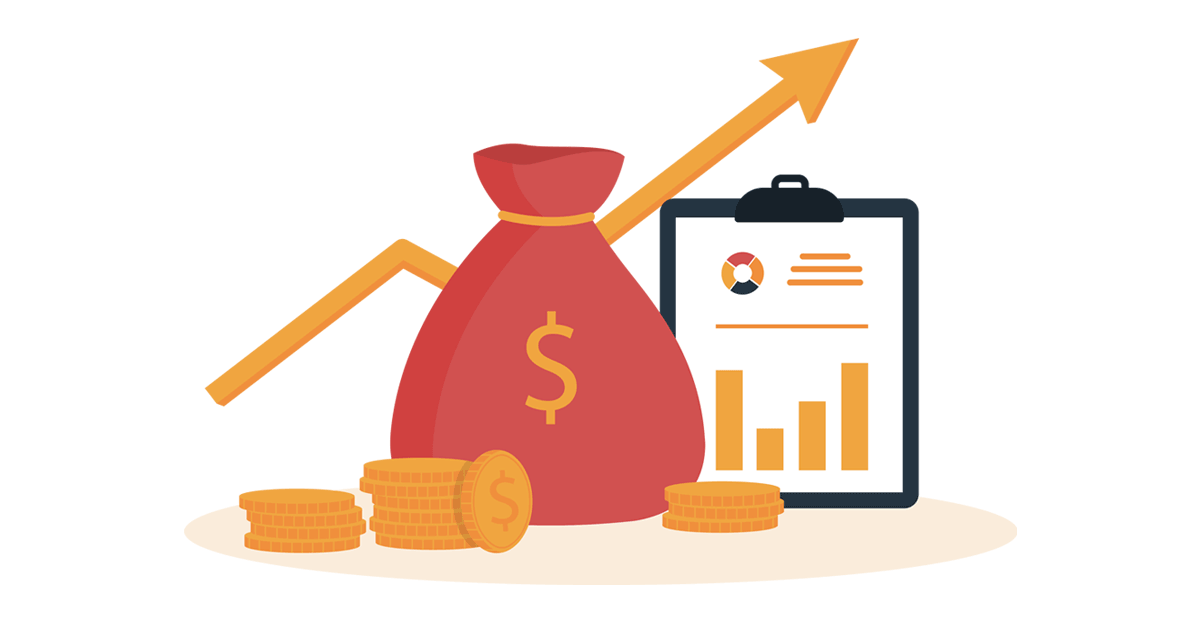Table of Contents
- 1 Amazon’s Profit Margin: Explained
- 2 Is Selling with Amazon Profitable in 2024?
- 3 How Much Can FBA Sellers Earn?
- 4 What Percentage of Merchants on Amazon Are Successful?
- 5 How to Earn a Good Amazon Profit Margin?
- 6 How to Calculate Profit Margins for a Particular Category?
- 7 Get More with Accurate Amazon Profit Margins!
- 8 What Are the Amazon Categories with the Best Profit Margins?
- 9 Protect Your Amazon Profit Margins with Monitoring!
Every seller knows that you need a good margin on Amazon to achieve success. However, not every seller is aware of what that percentage should be. But that’s okay — SellerSonar is here to help.
This article will dive into profit margins and explain how уou can estimate one that will work best for you and a good ROI (Return on Investment) for Amazon FBA (Fulfillment by Amazon).
Amazon’s Profit Margin: Explained
What is Amazon’s profit margin? We can define two types of profit margins: gross and operating. Gross margin is Amazon seller’s revenue minus basic costs to purchase products, while the operating one shows how much money they can put back into the business after-sales.
When it comes to seller’s fees, these are some of the expenses you can expect to encounter on Amazon.
- Seller Account Fee: It shows how much you should AMZ each month to keep your Seller Account. The basic plan accounts for $0.99 per item sold, while the Professional option with unlimited sales charges $39.99.
- Referral Fee: Regardless of the category you sell in, the platform will charge you a referral fee on every sale you make. It is a certain percentage of the product’s price.
- Variable Closing Fee: It shows how much you get charged on shipping the item and get taken off the sale total.
- FBA: There are many benefits of using the FBA program, but you have to pay particular fees (fulfillment fee per unit and monthly inventory storage fee).

Is Selling with Amazon Profitable in 2024?
For most sellers, Amazon FBA might be profitable this year. More than two-thirds of merchants report a profit margin of more than 10%.
However, it does not guarantee that you will see results immediately. Many aspected can influence your margins. For instance, a new seller might overtake you, or the market may become oversaturated. Being flexible to changing events will be vital to your success.
How Much Can FBA Sellers Earn?
Most merchants make $1 000 per month, with only 26% of sellers making less than this. So, Amazon is a great way to increase your current income.
Studies show that it’s possible to turn AMZ FBA into a full-time job. 40% of people surveyed earned $100 000 in lifetime sales. Besides, if you are particularly successful, you will make even more profits. For instance, 20 percent of vendors earn $50 000 per month.
What Percentage of Merchants on Amazon Are Successful?
92% of Amazon merchants make a profit, meaning it is likely that you will as well. How individuals define ‘success’ varies from seller to seller. Some merchants merely strive for additional disposable earnings, whereas others need to turn AMZ selling into a full-time job or sell their brand in the future.
How to Earn a Good Amazon Profit Margin?
Let’s begin with the basics: the ‘3 times rule’. It means that whatever you pay for a product, you must sell it three times to get a 100% return on investment, excluding all fees.
For instance, if you paid $1 for some products, you should sell them for $3 — the first $1 will cover the product initial cost, the second $1 will cover expenses, and the third $1 will be your 100% return on investment.
However, that is very simplistic and will not always work, especially if you factor in just how many categories and products there are on AMZ.
Consistency is better than inconsistent high margins.
If you face the choice of selling two products, one at a 20% margin and another at a 100% one, which would you opt for? Naturally, the latter.
What when we muddy the waters a bit by specifying that the lower-margin product has a selling rate of 90% and the better-margin one has a selling rate of 1? So, which one would you choose to become a successful AMZ seller?
Unless you aim to sell a ridiculously expensive product once and retire from the platform, your better bet is to sell the lower-profiting product that sells more consistently more often. It’s a much more profitable way of selling than the one-off. Besides, it gives you more opportunities to play around with variable costs, which we will look at next.
Keep a higher Amazon seller profit margin than your competitors.
Another aspect of running an eCommerce business on AMZ is that no number ever stays the same. So although it makes it tricky to 100% predict contribution margins and costs, it does provide you with a tremendous amount of flexibility to influence both.
Use advertising and marketing as an example. Say you decide to funnel 5% of your profits into ads and marketing until you get X dollars. Such a temporary cost might eat into your profit margins and cut it down to, say, 25%. However, once your campaign’s over, in case of success, it might lead to an increase of 45% profit margins, proving your one-time investment led to higher Amazon FBA earnings over the long run.
Manipulate operational costs to influence profit margins.
Another way merchants can affect their profit margin selling on Amazon is by closely tracking numbers. For example, try monitoring costs for a certain period, like 1-3 months, and evaluating which goods are selling well and which items might need to be replaced.
If you notice certain products are hanging around the platform’s warehouses and incurring long-term storage fees, a way to boost your profit margins is to lower the prices. Also, you can bundle the goods with other items to get rid of them promptly instead of paying the long-term storage fees.
Estimate how much you are paying on each product in the long run, then lower the item’s price by less than that. For instance, if you pay $0.50 a month on a product’s long-term storage fees and costs $2, reduce the price to something like $1.75 and market the heck out of it. Finally, evaluate if it is worth keeping around.
How to Calculate Profit Margins for a Particular Category?
How much can you make on AMZ FBA? To show you a quick example, here is a simple calculation based on one of the best-selling retail categories on Amazon in 2024: Furniture and Décor. For this instance, suppose you have a Professional plan and pay $3.75 per month for five cubic feet of storage space within nine months. On the platform’s seller pricing page, charges depend on the item’s category, dimensions, weight, and price.
Say you sell wall paintings with the following specifications:
Price: $549
Dimensions: 16″ x 10″
Weight: 4lbs
You can complete 20 paintings a month.
Step 1: Define your revenue
When selling each at $549, 20 paintings will earn you $10,980 a month.
Step 2: Calculate Total Costs
Handmade products are one of the categories with high-profit margins, so let’s cover that category.
Let’s say you need 12 hours to complete one painting and assess your work at $15 per hour. So in total, it’s $180 of labor. Plus, materials for $50, and your cost is $230 per painting. So the total production cost per month would be $4,600.
Then, don’t forget to determine applicable fees. The Amazon platform charges a category fee of 10% for décor over $200. So, in our case, it’s $54.90. Now, let’s proceed to the fulfillment fee. With your product’s weight and dimensions, it’s $5.80. Then, multiply the category and fulfillment fees by the total number of paintings. To summarize, your monthly fees are:
Storage fee: $3.75
Category fee: $1,098
Fulfillment fee: $116
Total fees: $1,098 + $116 + $3.75 = $1,217.75
Total costs: $4,600 (production costs) + $1,217.75 (fees) = $5,817.75
Step 3: Sum it up!
Now that we have revenue and total costs let’s plug it into the formula.
Revenue = $10,980
Costs = $5,817.75
Gross profit margin calculation formula:

Your net profit margin for paintings is 47%.
Of course, it’s just a demonstration of average income from selling on Amazon. To get the complete picture, sellers need to consider the market and industry situation.
Get More with Accurate Amazon Profit Margins!
So, now that you know how to calculate a reasonable Amazon FBA profit margin, you can set prices from an informed point of view. Remember that you should always think long-term and add seller fees to your costs to estimate Amazon margins on products accurately.
Besides, never forget that you are the person who knows your business best. Your brand belongs to you—no one else. Thus, the most valuable decision should be yours. With that in mind, experiment with Amazon’s profit margin calculator on different items. Then, the door is open to learning higher ROI.
What Are the Amazon Categories with the Best Profit Margins?
For most goods, margins vary between 17 and 26%. The following categories have the highest margins:
- Computers – 28%
- Handmade items – 26%
- Video games – 26%
- Books – 25%
- CDs and vinyl – 24%
- Apps and games – 24%
- Pet supplies – 23%
- Kitchen and dining – 23%
- Beauty and personal care – 23%
Protect Your Amazon Profit Margins with Monitoring!
To ensure that your Amazon profit margins are at the required level, you should keep track of the FBA fees that you are being charged and reimbursed for. With SellerSonar, you can monitor pricing trends on the market, check whether your competitors have changed their pricing policy, and minimize the risks of losing sales. What is also worth noting, the app operates in line with the platform’s terms of service and is approved by Amazon so that you can be 100% sure of its safety.
Start selling on Amazon and try SellerSonar’s 29-day free trial today for automated AMZ pricing monitoring and account management!


